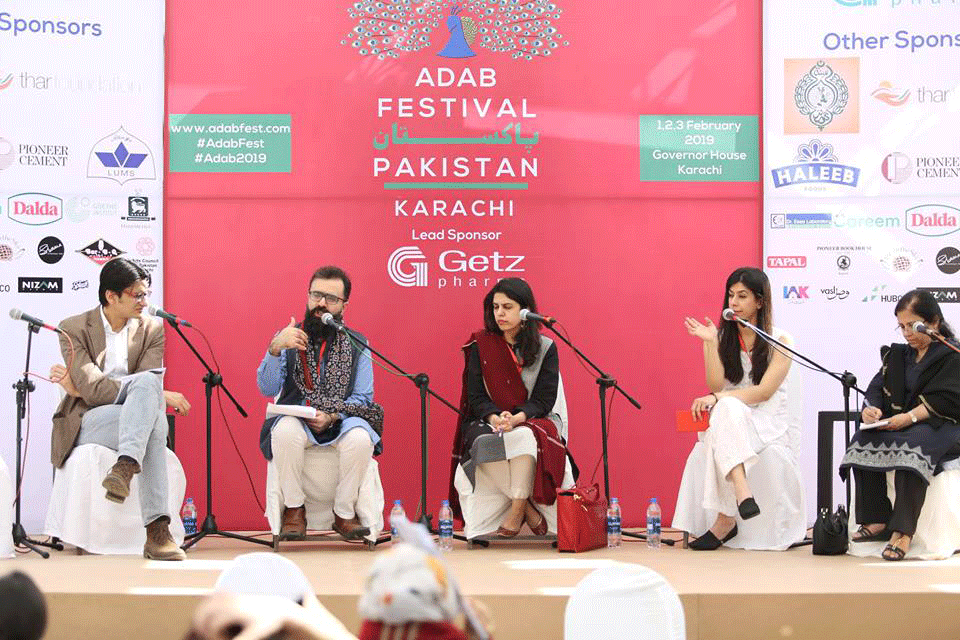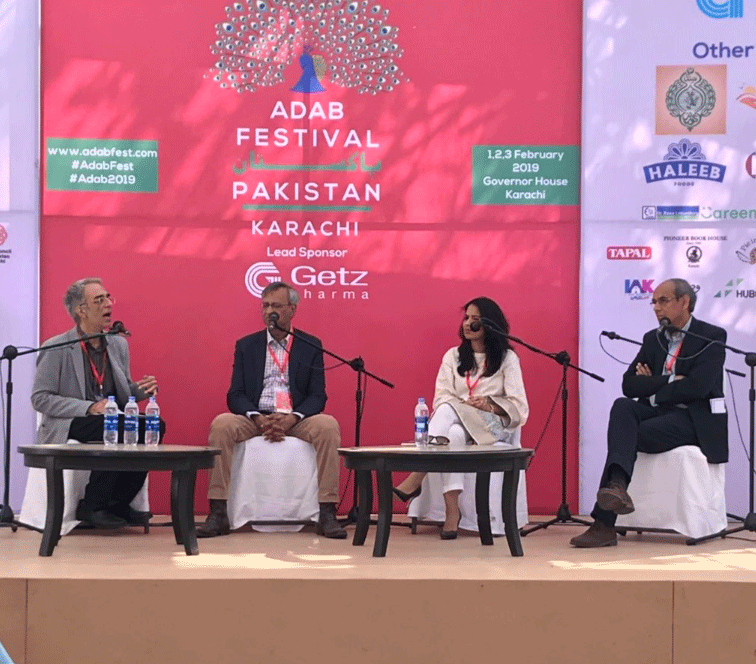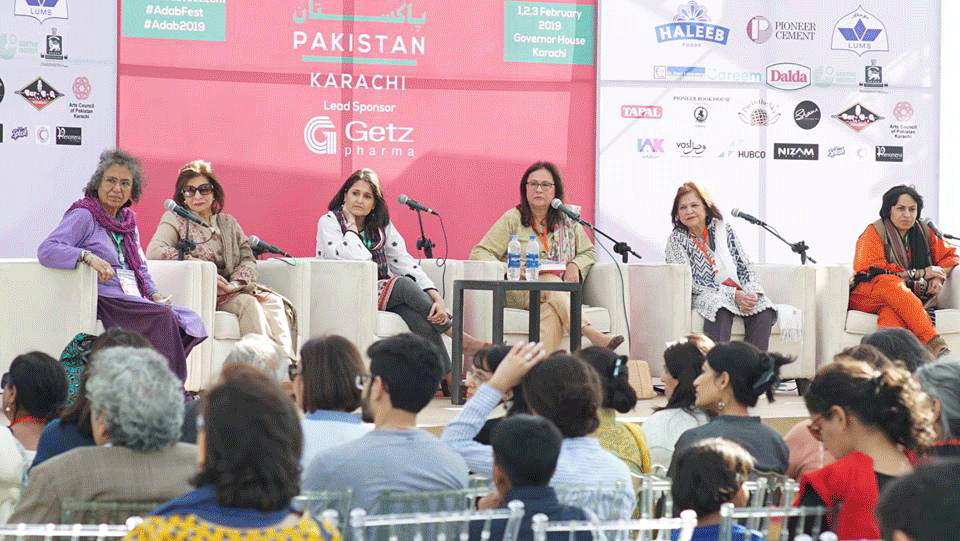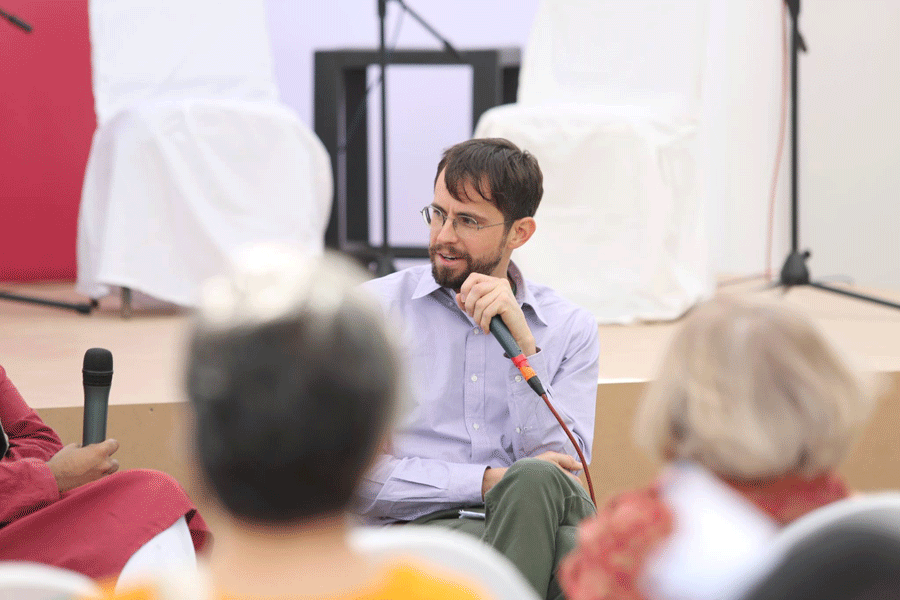Adab Festival 2019
By Newsline Admin | Literature | Published 6 years ago
Pakistan’s first Adab Festival, organised by Ameena Saiyid and Asif Farrukhi, was held on the first three days of February 2019, at the Governor House in Karachi. It hosted panel discussions, poetry recitals, book launches and a total of 153 participants, both local and international. Newsline reports on some of the sessions that were held at the Adab Festival.
Education as Ideology
By Zoha Liaquat
The panel, moderated by Ali Raza and comprising Tania Saeed, Ali Usman Qasmi, Anushay Malik and Dilshad Ashraf, discussed how textbooks in Pakistan inculcate and promote nationalist and Islamic ideologies.

Tania Saeed shed light on the issue, highlighting how Urdu textbooks, especially those published by the Punjab Textbook board, promote a more ‘conservative ideology.’ “There is immense normalisation of Islamic and nationalist values in these textbooks,” she said, adding that the ideal of patriotism promoted in language textbooks is often “uncritical and limits the imagination of a child.” A narrative in the grade 1 textbooks, for instance, asks, ‘What will you do to serve the country?’ and not, ‘what do you want to be when you grow up?’ All that is required in sustaining nationalism is this. It’s always about your duty to the State never about the State’s responsibility to you,” she added.
Speaking about her research project with a Christian community residing in Lahore, Anushay Malik commented on how the exclusionary nature of the curriculum often tends to have “very direct and real social effects on how Pakistani people feel in their everyday lives.” Narrating the details of a conversation she had with a prominent Pastor in Lahore, she added, “even when there isn’t any outright discrimination, the content in the curricula and the environment within the classroom all [seem to] suggest that it would be better if you were Muslim.”
Commenting on the country’s dismal literacy rate, Dilshad Ashraf said, “textbooks are one thing, but we also need to look at how the schooling system is governed.”
Members of the panel all agreed that the current curriculum, irrespective of which textbook board might have published it, requires serious change, and needs to include
narratives that allow students the much-needed opportunity to think critically.
Is Life Worth Living?
Joined onstage by Dr Murad Moosa, Dr Ayesha Mian and Azfar Naqvi, who lost a son to depression, moderator Zarrar Khuhro began the discussion by highlighting the recent rise in suicides around the country. Dr Ayesha Mian spoke about the role of academic institutions in creating a healthy environment for students, instead of “focusing solely on academics.” Mian blamed academic institutions for creating high-pressure environments for students that do not necessarily help nurture them. “Almost 50 per cent of our students are suffering from some level of anxiety or stress and perhaps depression, and there just aren’t enough resources to address this issue,” she added.

Commenting on the lack of resources, Dr Murad Moosa said that the country’s limited pool of psychiatrists and psychologists – 400 to 450 each – are mostly settled in the big cities while a large portion of the population resides in rural areas. “There is no certified exam for it in any medical college other than the Aga Khan University, which really means that doctors graduate without having been exposed to even the most basic of mental health issues,” said Moosa, as he discussed the shortcomings of the medical academia in Pakistan.
Commenting on the perceived link between mental health and religious beliefs in Pakistan, Azfar Naqvi urged those in attendance to withhold judgement: “Whether it’s religion or any other reason, we as a society are very quick to judge. [When someone comes to us with an emotional or mental struggle] We say, ‘Namaz parho, sahi hojao ge.‘ I request you not to make a snap judgement. Some of them may have been spiritual and religious; there are much larger issues at play.”
The Women’s Movement in Pakistan

Author Ayesha Khan, along with panelists Amar Sindhu, Sheema Kermani, Sultana Siddiqui, Uzma Noorani and Anis Haroon, discussed her book, The Women’s Movement in Pakistan: Activism, Islam and Democracy, and the need to highlight the journey of women’s activism in Pakistan and bridge the gap between the older and younger generation of female activists. “It’s for the younger generation to highlight the struggles women went through for their rights. Most of the documentation work produced by activists in the ’80s has gone out of print,” said Khan, adding that her book was centred around WAF’s (Women’s Action Forum’s) journey of political activism.
Panelists Amar Sindhu and Anis Haroon spoke about women’s activism during General Zia-ul-Haq’s regime, detailing the country’s environment following the notorious Hudood Ordinance. Haroon said, “We felt that if we didn’t speak up, our country would become another Saudi Arabia. Women who were locked up for Zina were the underprivileged. Our struggle was for the common woman. We challenged Zia, we asked for the restoration of the 1973 constitution – this was in 1981. We used to talk openly about the Blasphemy Law; we used to protest against the persecution of Ahmedis, but you can’t do that anymore.”
Haroon also spoke about the younger generation of female activists and the popularity of their slogan ‘Khana khud garam karlo,’ adding that theirs was more a fight for personal freedoms. However, panelist Sheema Kermani was quick to point out that activism can take many forms and does not necessarily have to be against the state, and that these slogans also challenge patriarchy.
Sultana Siddiqui commented on the role of the media in political activism. “When I started my channel, I made sure that besides the entertainment aspect, there was an element of activism as well,” said the HUM Network president.
Safarnamas by women of pre-Partition India
By Deneb Sumbul
On the third day of the Adab Fest, there was an absorbing session on ‘The Forgotten History of Women’s Travel Writing in Urdu’ moderated by Dr. Yaqoob Bangash. The discussion centred around the Urdu safarnama based on Dr. Daniel Majchrowicz’s research – particularly the travelogues written by women of the Subcontinent in Urdu and Punjabi, in the 19th and 20th centuries. Incidentally, that is the subject of his soon-to-be-published book, Veiled Voyagers: Muslim Women Travellers from Asia and the Middle East.

Clearly fascinated by the subject, Dr Majchrowicz surprised the audience by reading, in flawless Urdu, travel accounts of the women that belonged to the gentry. Before the mid-19th century, travel accounts barely existed in Urdu. He explained their sudden appearance, and why women in particular took to this genre. He gave a background of some of the earliest women authors and their observations on the world.
The largest number of travelogues published in India were in Urdu, even though the language of the educated class was Persian until the end of the 19th century. Dr Majchrowicz surmised that this may very well have to do with the decision of the British Raj to make Urdu the official language of the administration. When the printing press came to India, publishing became accessible and cheap in the 1840s and books, newspapers and magazines were being printed, thus creating a huge literary space where people started sharing their ideas and travel writing moved into that space.
Travel writing was also introduced in the colonial syllabus, and people took it up very quickly and made it their own – in prose and poetry. If a trip was really painful, some would make it sound like a marsia, lamenting all the unfortunate mishaps of the journey.
The first known travel account to be published by a woman was that of Nawab Sikandar Begum of Bhopal, who wrote of her Hajj pilgrimage in 1870. There was very little space for women to write and publish a book in their own name at that time. But gradually their work, travelogues in particular, began to be published in magazines such as Tehzeeb and often they would address their works to, ‘Meri Tehzeebi behnain’ (my Tehzeebi Sisters).
“I really am excited about this; it’s been a great project,” says Dr Majchrowicz of his forthcoming book. He found it amusing that 90 per cent of the women travel writers he researched, began their travelogues saying, “It was nothing special, but my friends insisted so much that I felt compelled to write.” Obviously, this was not true, as they were taking copious notes throughout their trips.
Several women from educated families wrote travelogues in magazines under their own name. Purdah was talked about a lot in these accounts, not because the women were interested in the subject, but because they wanted to emphasise that they had travelled while in purdah, so as to appear socially acceptable.
Dr Majchrowicz read excerpts from the work of Sarwat Ullah Jung (Akhtar-un-Nissa), who was closely related to the Nizams of Hyderabad and, through marriage, to Sir Syed Ahmed Khan of the Aligarh movement. In 1910 she travelled abroad and wrote a diary, but she published it in book form 25 years later in 1937, after her husband had died. Titled, Duniya Aurat ki Nazar Mai – Mashriq aur Maghrib ka Safarnama, her travel accounts revolve around her desire to learn about other women’s lives.
For the most part, women travelled with their husbands, although some made exceptions for Hajj. The popular destinations in women’s travelogues were a mix of religious sites, such as Makkah, Madina, Ziarat, Najaf, Karbala and tourist sights, such as England, Paris, Switzerland and Istanbul. Interestingly, it was only around 1850 that America started to appear on the list of destinations.


